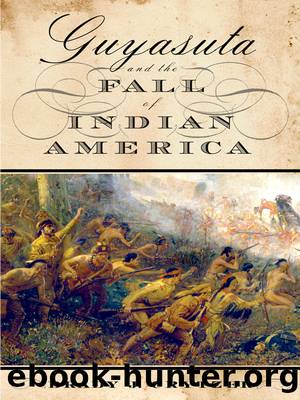Guyasuta and the Fall of Indian America by Crytzer Brady J.;

Author:Crytzer, Brady J.;
Language: eng
Format: epub
Publisher: Westholme Publishing
SIX
Unwavering Commitment
DUAL ALLIANCES IN AN AGE OF UNREST
Guyasuta was one of many sachems inside the foreboding walls of Fort Pitt, and he had found himself in a familiar situation. Though the British Crown had announced that no Anglo-Americans would be allowed to settle and survey Indian lands, since the rebellion had ended they had done just that.
Guyasuta was in an unenviable position. Since he first visited Johnson Hall two years earlier, he had become a valuable ambassador to the Indians of the Ohio Country. He was a trusted ally of Sir William Johnson, and the two of them often toiled in pursuit of plans to maintain a fair and equitable policy of British North America toward its Indian peoples. Guyasuta therefore had to wear two hats; to the British he had to present Indian complaints, and to his own people he was a sounding board. His loyalty was always to his native brethren, but he often was placed in the middle of a continual struggle that pulled him in all directions. For peace to truly prevail, Guyasuta knew that the Indians had to remain a present issue in the larger scope of imperial policy makers, but the Ohioans themselves also had to be willing to make some concessions. He was joined at council by the Ohio Country's foremost leaders, including Tamaqua and Custaloga. With a copy of John Bradstreet's disgraced treaty of 1764, Guyasuta rose and spoke: âBy this treaty we agreed that you had a right to build forts and trading-houses where you pleased, and to travel the road of peace from the sun rising to the sun setting. At that treaty the Shawanese and Delawares were with me, and know all this wellâ¦be strongâ¦and wipe away the reproach of their former breach of faith, and convince their brothers the English that they could speak the truth.â1
Since late April, Guyasuta had been acting as the primary orator to his British counterparts at Fort Pitt, and though he had a good working relationship with George Croghan, the key diplomat stationed at the fort, the two men were finding very little common ground. As Guyasuta spoke over the two-week session, he straddled his duties of representing the angry Ohioan chiefs and appearing as reasonable to the British. The result was great discontent among all parties, and the fact that there was not an official document on which either side could base its argument meant that the council was essentially meaningless. The British had outlawed settlements, but the 1763 motion was never meant to be permanent. The Crown had no way of genuinely controlling Anglo immigration into Indian territory. Aware of this, hundreds of settlers flooded the Ohio River valley to carve out their own homesteads, paying no mind to its standing Indian occupants.2
Sir William Johnson spent much of 1768 attempting to explain this to his superiors. Because no document existed to protect Indian rights, or at least define their land in some way, the problems of the Indian rebellion that began five years earlier were certain to surface yet again.
Download
This site does not store any files on its server. We only index and link to content provided by other sites. Please contact the content providers to delete copyright contents if any and email us, we'll remove relevant links or contents immediately.
| Americas | African Americans |
| Civil War | Colonial Period |
| Immigrants | Revolution & Founding |
| State & Local |
In Cold Blood by Truman Capote(3133)
Steve Jobs by Walter Isaacson(2759)
The Innovators: How a Group of Hackers, Geniuses, and Geeks Created the Digital Revolution by Walter Isaacson(2473)
All the President's Men by Carl Bernstein & Bob Woodward(2260)
Lonely Planet New York City by Lonely Planet(2098)
The Room Where It Happened by John Bolton;(2031)
And the Band Played On by Randy Shilts(2007)
The Murder of Marilyn Monroe by Jay Margolis(1974)
The Poisoner's Handbook by Deborah Blum(1970)
The Innovators by Walter Isaacson(1967)
Lincoln by David Herbert Donald(1866)
A Colony in a Nation by Chris Hayes(1794)
Under the Banner of Heaven: A Story of Violent Faith by Jon Krakauer(1680)
Amelia Earhart by Doris L. Rich(1582)
The Unsettlers by Mark Sundeen(1580)
Birdmen by Lawrence Goldstone(1530)
Zeitoun by Dave Eggers(1514)
Dirt by Bill Buford(1513)
Decision Points by George W. Bush(1462)
